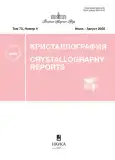Temperature dependence of elastic moduli and period of magnetic spirals in cubic helimagnets with spins in non-equivalent positions
- 作者: Chizhikov V.A.1,2, Dmitrienko V.E.2
-
隶属关系:
- National Research Center “Kurchatov Institute”
- MIREA — Russian Technological University
- 期: 卷 70, 编号 4 (2025)
- 页面: 637–642
- 栏目: ФИЗИЧЕСКИЕ СВОЙСТВА КРИСТАЛЛОВ
- URL: https://rjsvd.com/0023-4761/article/view/688087
- DOI: https://doi.org/10.31857/S0023476125040123
- EDN: https://elibrary.ru/JGLDGY
- ID: 688087
如何引用文章
详细
Critical phenomena in cubic helimagnets with nonequivalent magnetic atoms are investigated within the framework of the Weiss mean-field theory. The reason for the appearance of temperature dependences of elastic moduli and the pitch of the magnetic helicoid is found and the form of these dependences, determining the change in the conditions for the appearance of magnetic skyrmions in type II multiferroic Cu2OSeO3, is predicted.
全文:
作者简介
V. Chizhikov
National Research Center “Kurchatov Institute”; MIREA — Russian Technological University
编辑信件的主要联系方式.
Email: chizhikov@crys.ras.ru
Отделение “Институт кристаллографии им. А.В. Шубникова” Курчатовского комплекса кристаллографии и фотоники
俄罗斯联邦, Moscow; MoscowV. Dmitrienko
MIREA — Russian Technological University
Email: chizhikov@crys.ras.ru
俄罗斯联邦, Moscow
参考
- Bogdanov A., Hubert A. // Phys. Status Solidi. B. 1994. V. 186. P. 527. https://doi.org/10.1002/pssb.2221860223
- Bogdanov A., Hubert A. // J. Magn. Magn. Mater. 1994. V. 138. P. 255. https://doi.org/10.1016/0304-8853(94)90046-9
- Rößler K., Bogdanov A.V., Pfleiderer C. // Nature. 2006. V. 442. P. 797. https://doi.org/10.1038/nature05056
- Grigoriev V., Maleyev S.V., Okorokov A.I. et al. // Phys. Rev. B. 2006. V. 74. P. 214414. https://doi.org/10.1103/PhysRevB.74.214414
- Münzer W., Neubauer A., Adams T. et al. // Phys. Rev. B. 2010. V. 81. P. 041203. https://doi.org/10.1103/PhysRevB.81.041203
- Adams T., Mühlbauer S., Pfleiderer C. et al. // Phys. Rev. Lett. 2011. V. 107. P. 217206. https://doi.org/10.1103/PhysRevLett.107.217206
- Стишов С.М., Петрова А.Е. // Успехи физ. наук. 2011. Т. 181. С. 1157. https://doi.org/10.3367/UFNr.0181.201111b.1157
- Seki S., Yu X.Z., Ishiwata S., Tokura Y. // Science. 2012. V. 336. P. 198. https://doi.org/10.1126/science.1214143
- Adams T., Chacon A., Wagner M. et al. // Phys. Rev. Lett. 2012. V. 108. P. 237204. https://doi.org/10.1103/PhysRevLett.108.237204
- Seki S., Kim J.-H., Inosov D.S. et al. // Phys. Rev. B. 2012. V. 85. P. 220406(R). https://doi.org/10.1103/PhysRevB.85.220406
- Onose Y., Okamura Y., Seki S. et al. // Phys. Rev. Lett. 2012. V. 109. P. 037603. https://doi.org/10.1103/PhysRevLett.109.037603
- Беляков В.А., Дмитриенко В.Е. // Успехи физ. наук. 1985. Т. 146. С. 369. https://doi.org/10.3367/UFNr.0146.198507a.0369
- Wright D.C., Mermin N.D. // Rev. Mod. Phys. 1989. V. 61. P. 385. https://doi.org/10.1103/RevModPhys.61.385
- Tewari S., Belitz D., Kirkpatrick T.R. // Phys. Rev. Lett. 2006. V. 96. P. 047207. https://doi.org/10.1103/PhysRevLett.96.047207
- Binz B., Vishwanath A., Aji V. // Phys. Rev. Lett. 2006. V. 96. P. 207202. https://doi.org/10.1103/PhysRevLett.96.207202
- Hamann A., Lamago D., Wolf T. et al. // Phys. Rev. Lett. 2011. V. 107. P. 037207. https://doi.org/10.1103/PhysRevLett.107.037207
- Дзялошинский И.Е. // ЖЭТФ. 1957. Т. 32. С. 1547.
- Dzyaloshinsky I. // J. Phys. Chem. Solids. 1958. V. 4. P. 241. https://doi.org/10.1016/0022-3697(58)90076-3
- Moriya T. // Phys. Rev. Lett. 1960. V. 4. P. 228. https://doi.org/10.1103/PhysRevLett.4.228
- Moriya T. // Phys. Rev. 1960. V. 120. P. 91. https://doi.org/10.1103/PhysRev.120.91
- Bak P., Jensen M.H. // J. Phys. C. 1980. V. 13. P. L881. https://doi.org/10.1088/0022-3719/13/31/002
- Nakanishi O., Yanase A., Hasegawa A., Kataoka M. // Solid State Commun. 1980. V. 35. P. 995. https://doi.org/10.1016/0038-1098(80)91004-2
- Chizhikov V.A., Dmitrienko V.E. // J. Magn. Magn. Mater. 2015. V. 382. P. 142. https://doi.org/10.1016/j.jmmm.2015.01.032
- Чижиков В.А. // ЖЭТФ. 2021. Т. 159. С. 656. https://doi.org/10.31857/S0044451021040076
- Chizhikov V.A., Dmitrienko V.E. // J. Phys.: Condens. Matter. 2024. V. 36. P. 165603. https://doi.org/10.1088/1361-648X/ad1bf8
- Keffer F. // Phys. Rev. 1962. V. 126. P. 896. https://doi.org/10.1103/PhysRev.126.896
- Yang J.H., Li Z.L., Lu X.Z. et al. // Phys. Rev. Lett. 2012. V. 109. P. 107203. https://doi.org/10.1103/PhysRevLett.109.107203
- Janson O., Rousochatzakis I., Tsirlin A.A. et al. // Nat. Commun. 2014. V. 5. P. 5376. https://doi.org/10.1038/ncomms6376
- Chizhikov V.A., Dmitrienko V.E. // J. Phys.: Condens. Matter. 2017. V. 29. P. 155601. https://doi.org/10.1088/1361-648X/aa61e7
补充文件













